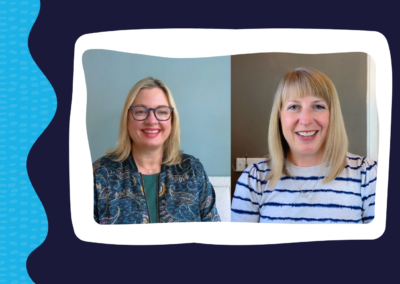As the popularity of freelance work keeps growing, a familiar problem looms ever larger for independent marketers: how do you stand out in a crowd? How can you establish a unique, identifiable personal brand?
Veteran brand designer and We Are Rosie community member Michael Diaz has a simple, if amusing, solution: “Lean into your weirdness—that combination of vulnerable quirk, passion, or perspective that few people even know about!” he urges.
Michael practices what he preaches. A perfect example of this is his hilariously memorable Amazon page resume.
“I’ve helped brands create hundreds of product galleries over the years,” he says. “Eventually the thought hit me, ‘why not make a product gallery of myself?'”
Michael has done a ton of product launches. Throughout his 12-year career in brand identity design, he has played a key role in directing the creative vision for more than 300 product launches, securing over $500k in annual B2B toy sales, leading the development of web and app projects, and crafting communications and product designs for prominent brands such as Amazon, Major League Baseball, and the National Basketball Association. He’s currently a contracted creative director for multiple ongoing projects with creative agency Big Vision in Orlando, FL.
But back to the weird factor
Growing up, Michael often felt like the odd one out, the bullied kid, the nerd. Eventually, he realized that his identity as a second-generation Cuban-American with belated social skills gifted him with the disruptive “outsider” perspective he needed as a creative professional. To him, being different is more than just a whimsical concept; it’s an undeniable requirement and identity pillar.
“Standing out as a brand requires asking the question: are you a category supporter or a category challenger?” Michael says. “The more you’re a category supporter, falling in line with what everyone else is doing, the greater your risk of blending into the background.”
“Leaning into your quirks, your odd goodness, puts you on the path to challenging your category. By standing for this previously sidelined part of themselves, the best brands stand out.”
For Michael, leaning into the quirks and strangeness of who you are is complementary to the practice of lateral thinking. When ideating, or laterally thinking through a solution, it helps to avoid labeling and seeking the “right” approach. Instead, lean into the illogical and offbeat to brainstorm laterally for quantity instead of linearly for quality.
“Regardless of whether you call it ‘challenging the category’ or ‘leaning into weirdness,’ you can use lateral thinking to get you there,” he explains. “When thinking persistently for quantity is part of your solution process, you will inevitably stumble across something that resonates. By using divergent thinking, we can uncover the best way to express our most authentic self. It gives us the space to relentlessly ask questions like ‘what do I really want to do?’ and ‘what’s my superpower?’”
Isn’t weirdness risky?
While weirdness and lateral thinking are thought-provoking, you might be wondering whether there’s risk in this approach. To that, Michael offers an enthusiastic “yes!”
“Every action holds an inherent risk,” he says. “One of the biggest risks I can think of is doing what everyone else is doing and not disrupting the norms of an industry. Refusing to stand out, being reluctant to challenge industry communication standards, is one of the riskiest decisions we can make as business owners.”
When talking to Michael, it’s obvious he’s a fountain of ideas about creativity and how to use it. But does he ever get stuck in a creative rut or feel uninspired?
“I’ve definitely encountered my fair share of ruts and walls,” he says. “When that happens, the best thing for me to do is keep working, resting, working, and resting.”
“I follow this guy on YouTube who says that when an inexperienced artist encounters a wall, they stop working, get frustrated and look for things to blame or reasons to quit, and inevitably resent the ‘work.’ The experienced artist persists, well aware of and expecting the incoming ‘wall.’ By putting my faith in the creative process, maintaining a consistent work/rest cycle, and relying on the support of my team, I inevitably break through any creative block.”
Michael sees similarities between his approach to creativity and the concept of muscle memory, where repetition and persistence build strength and agility.
“At the start of a project, I actively seek to make the most terrible ‘dog-water’ designs possible, to clear out the attic,” he says. “Getting every concept out in the open from the get-go primes my mind to reduce its filters and make progressively larger and larger degrees of free association. This is the best way I’ve found to reduce perfectionism and open doors foreign to the most established leaders.”
The client deserves to find the best fit
Michael knows that his approach might not resonate with every client. He urges freelancers to embrace their independent status and see opting out of work as an expression of respect for themselves and potential clients.
“When I first interact with a new client, I focus on raising my intuition,” he says. “Are our interactions positive and energizing, or is our conversation disjointed? I have a responsibility to myself and to the client to encourage them to find the best fit possible—even if it’s with another contractor.”
“We all deserve to have a positive relationship with the people we work with,” Michael adds. “That’s one of the joys of being independent. As a freelancer, I owe it to myself and my clients to build up a minimum of six months of floatable savings. It gives me the flexibility and space to recognize if a project is a good fit. This honors the best interest of myself and those I work with.”
Many employers, burned in the past by unqualified or overextended freelancers, may perceive contractors as being risky (there’s that word again). But Michael insists that to succeed, independent workers may have more hard-won discipline, self-motivation, and flexibility than people in conventional, full-time positions.
“In a regular office setting, it may be easier to coast as long as you’re on the clock,” concludes Michael. “However, as a freelancer, you’re often held accountable for every hour and deliverable. The self-starter who gets results? They thrive.”
“Today, we have the flexibility to live anywhere while supporting major brands around the world. That flexibility and exposure to diverse environments gives brands a defensible edge when outsourcing. New talent often sidesteps the pitfalls of group-think with fresh perspectives and contagious discipline. Divergence at its finest.”



